Americas
How one of the coldest, darkest towns on Earth is trying to get more energy from the sun
The Washington Post March 9, 2024
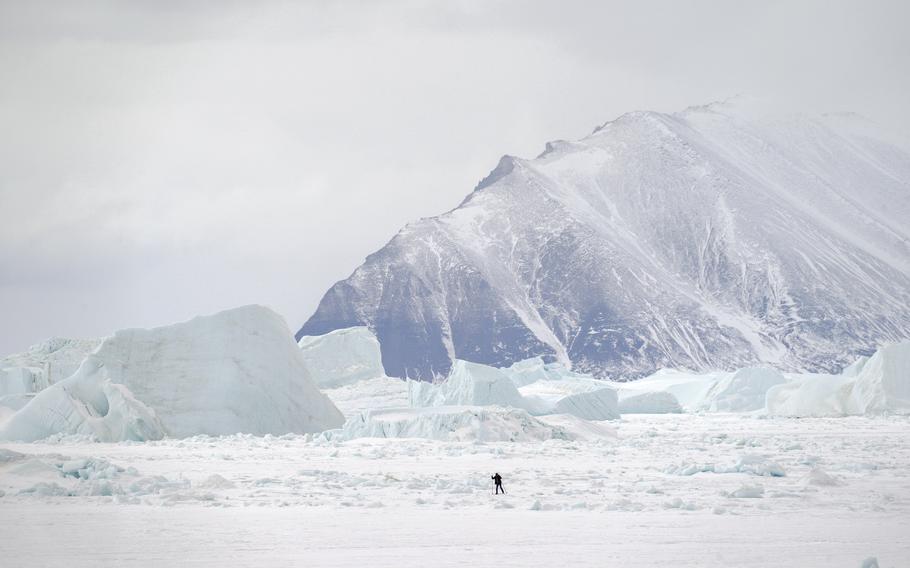
A skier passes icebergs while crossing the sea ice. Climate change imperils the traditional ways of life in Qaanaaq. (Bonnie Jo Mount/The Washington Post)
QAANAAQ, Greenland — Out on the ice, Toku Oshima often says, “there is no time.” No calendar but the migrations of sea creatures. No clock but the cadence of the tides. She can hunt and fish the same way her parents did, and their parents before them: traveling by dog sled, sleeping in a wooden hut she built with her own hands. In the rugged mountains and frozen fjords that surround Greenland’s northernmost town, the old ways are still alive.
But those ways are under threat. Human-caused climate change has scrambled weather patterns and pushed the rhythms of animals out of sync with the ice and sun. Residents struggle to earn a living through hunting and fishing, which leaves them unable to afford the imported oil that keeps their homes warm and lit during the long Arctic night. The high cost of electricity and heat has forced some people to abandon their traditional livelihoods — or to leave the town altogether.
Qaanaaq residents should be able to heat their homes without sacrificing their culture, Oshima said. But that will require them to cast off the culprit behind their dual challenges of climate change and energy security: fossil fuels.
Together with scientists and engineers from Dartmouth College, Oshima is working to bring renewable energy to one of the most remote places on Earth. Drawing power from local wind and sunshine can reduce the cost of living in Qaanaaq, easing financial pressures on residents who already live at the edge of survival. And it can help the town do its part to rein in the planet-warming pollution that threatens its very existence.
The effort is in its infancy, with Oshima’s Dartmouth partners still developing the equipment they hope to install. To succeed in such an isolated and harsh environment, they are leaning on the expertise of those who thrived in this landscape for generations. Each prototype is designed specifically for conditions in Qaanaaq and tested by the residents themselves.
Dartmouth College engineer Mary Albert, the U.S. co-leader for the project, sees it as a potential model for sustainability efforts the world over. “It’s cogeneration of knowledge,” she said, “so they can continue to live where they want to live and how they want to live.”
To Oshima, the initiative is her “gift to the next generation” — an investment in Qaanaaq’s future that makes space for the traditions of its past.
“If we want to keep more people, we have to make more energy,” she said. “It’s our culture. We’re trying to keep our culture.”
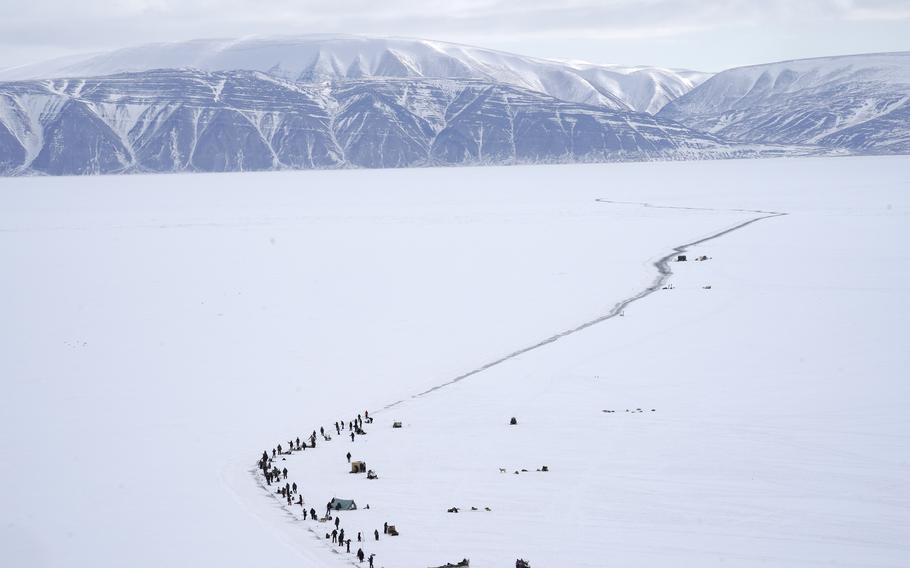
Families fish along a crack in the sea ice. The community relies on fishing and hunting for subsistence. (Bonnie Jo Mount/The Washington Post)
Located less than 1,000 miles from the North Pole, Qaanaaq can sometimes feel like “the end of the world,” Oshima said. Some 650 people live in the hamlet of brightly colored wooden buildings, perched on a narrow stretch of bare land between the gargantuan Greenland Ice Sheet and the frigid waters of Baffin Bay. There are no roads linking Qaanaaq to the rest of the country. Visitors, groceries and other essentials can only come on twice-weekly planes.
The town didn’t even exist until 71 years ago, when residents were forcibly relocated from their ancestral village on a fjord to the south to make way for a U.S. Air Force Base.
Yet there is a unique spirit in Qaanaaq, Oshima said: “We have ocean views, we have mountains. We never feel like someone is pushing you down.”
Oshima is something of an unofficial leader for the town. As a skilled craftswoman, trained electrician and one of few women with a hunter’s license, she commands respect from men and women alike.
To Qaanaaq’s children, she is “Aunt Toku” — provider of sweets, fishing trips and sewing lessons. She shows them how to identify cracks in the ice and predict the weather. She teaches them to clean the meat and hair from seal skins, reminding them, “If you want to make it beautiful, you have effort and patience.”
Oshima tries to stoke the kids’ ambitions, hoping that they will look at her — a woman with modern skills who maintains the traditions of her ancestors — and imagine bigger futures for themselves.
“I want to show what is possible,” she said.
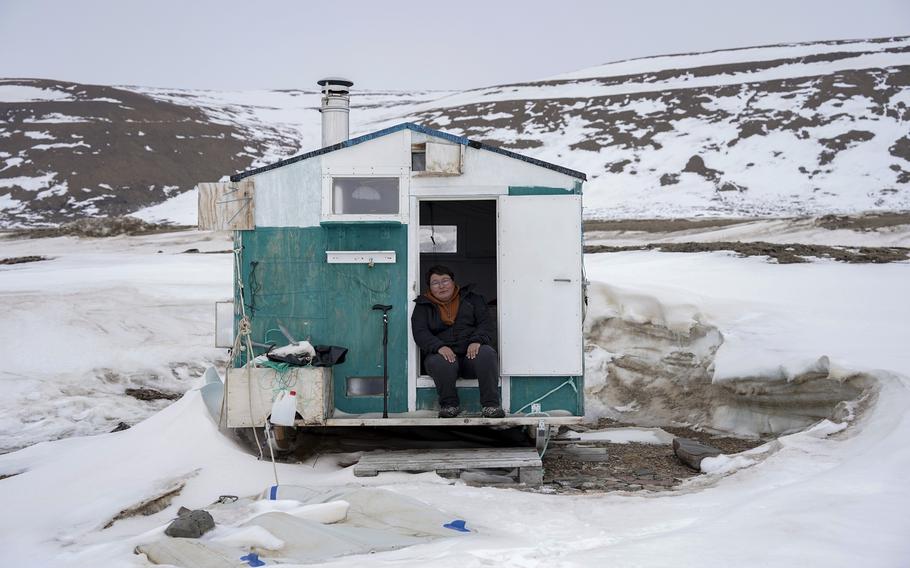
Toku Oshima a hunter worried about climate change, is seen at her fishing camp. She hopes to get her community to shift to greener sources of energy. (Bonnie Jo Mount/The Washington Post)
Yet the possibilities available to the people of Qaanaaq are increasingly constrained. Climate change — combined with tighter regulations and restrictions on animal exports — imperils their traditional livelihood of hunting seals, walrus and narwhal, residents say. Strong winds and rough waves increasingly fracture the sea ice that hunters need to operate. The too-warm ocean stays unfrozen until weeks after the long polar night sets in, creating conditions too dark and dangerous for them to work.
Dwindling incomes from hunting can’t keep up with the price of residents’ modern needs, like cellphones and groceries.
“Everything costs now,” said Adolf Simigaq, the vice president of the local hunters’ union.
Especially power. All of Qaanaaq’s electricity comes from a diesel generator, and most homes are heated with oil. Fuel is delivered once per year, during the brief window in summer when the sea ice melts and ships can come to shore.
Although Denmark heavily subsidizes the shipments as part of the territory’s self-government agreement, the intense cold and long stretches without sunlight mean energy demand is sky high. Many families spend more on heat and electricity than they do on food.
“Our numbers have become very few,” said Sofus Alataq, a union member. Most young adults in Qaanaaq seek jobs in town, or else move south to work in one of Greenland’s larger, more accessible communities. Some residents have been forced to kill their sled dogs when they could no longer afford to feed them.
The consequences of this shift will extend beyond Qaanaaq, Alataq said. Almost nowhere else in Greenland — or in the entire Arctic — do people still hunt by kayak and fall asleep to the ancient chorus of sled dogs yipping and howling through the long polar night. If those traditions cannot survive here, he worries, they might vanish from the Earth.
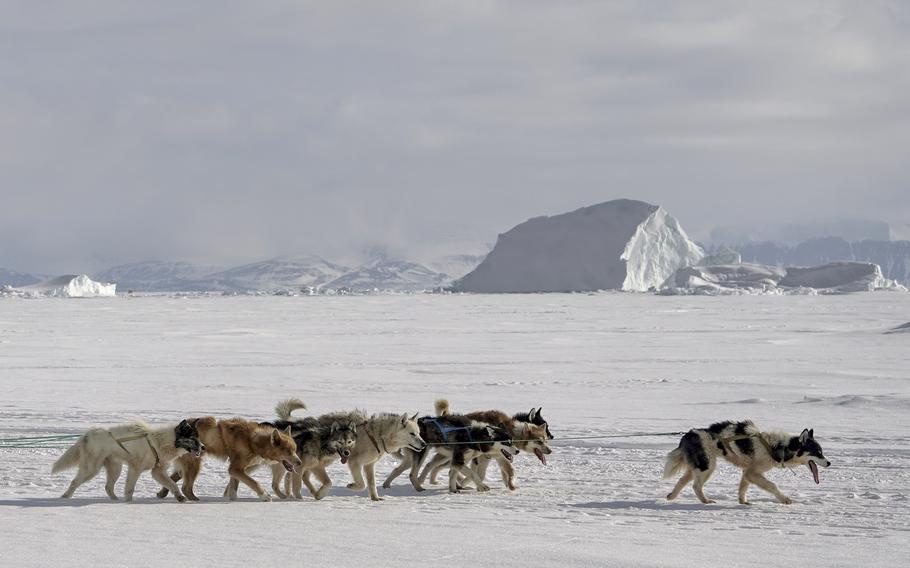
Greenland dogs at work. The dogs are essential to hunting and the country protects their purity. In Qaanaaq and other villages north of the Arctic Circle, no other kind of dog is permitted. (Bonnie Jo Mount/The Washington Post)
Oshima was mulling that same concern as she listened to a Dartmouth College professor named Mary Albert during a 2015 conference. The presentation mostly reinforced what Oshima already knew: that rising temperatures in the Arctic were irrevocably changing her home.
But Albert also had good news. Renewable energy sources were becoming more affordable, she said. The scientist described how solar panels at her Vermont home were curbing pollution and cutting electricity costs.
That got Oshima thinking: Could Albert come to Qaanaaq and help bring renewable energy to the town?
Albert’s first impulse was to decline Oshima’s request. She was a snow and ice researcher - not an energy system expert.
“But then I thought, ‘What a cop-out. You’re an engineer,’” Albert recalled. “‘They’re not asking you to help them invent the next thin film solar panels - they want practical things.’”
A few months later, Albert made the arduous and expensive multiday journey from Vermont to Qaanaaq. As she went from home to home, she heard residents describe how reliance on fossil fuels left them vulnerable to supply chain disruptions and dependent on government subsidies that might not always be there. They wanted a cheap and stable source of power that would help them secure modern comforts while maintaining their ancient traditions.
Oshima appreciated Albert’s desire to make a difference - a contrast to other Arctic researchers who drew on community members’ knowledge of the landscape and wildlife without offering anything in return.
“They want to help, not just look,” she said.
“Alone in Qaanaaq, we cannot do anything,” she added. “We have to find allies somehow.”
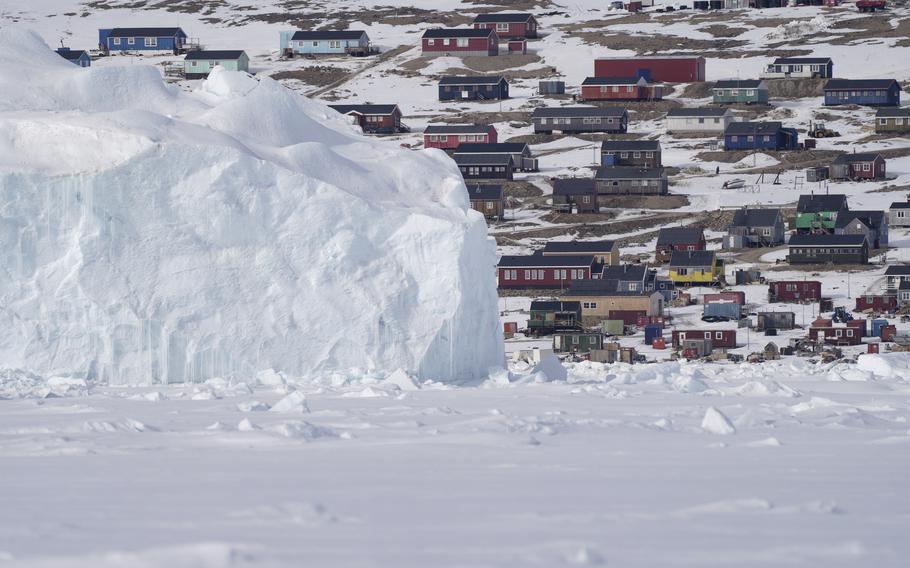
In Qaanaaq, Greenland, residents live between the gargantuan Greenland Ice Sheet and the frigid waters of Baffin Bay. (Bonnie Jo Mount/The Washington Post)
Not long after her visit, Albert was able to secure $2.6 million in funding from the National Science Foundation and pulled together a team of fellow Dartmouth researchers who could craft a strategy to meet Qaanaaq’s needs.
They called their initiative “Qulleq,” a Inuktun word for the soapstone lamps Greenlanders once used to light their homes.
The team soon realized shifting Qaanaaq away from fossil fuels would be an uphill challenge. Ice can interfere with the function of wind turbines; batteries drain rapidly in the cold.
Qaanaaq’s remoteness added more obstacles. The Dartmouth team could only visit Qaanaaq twice a year, and the town had no trained technicians to service malfunctioning machinery in the meantime. If a piece of equipment broke, residents might have to wait a whole year for the summer supply ships to deliver a replacement.
Oshima offered a cautionary tale from Qeqertat, a nearby village where Greenland’s state-owned energy company, Nukissiorfiit, tried installing solar panels. The system was designed just like those in more temperate locations, relying on inverters to change the panels’ direct current electricity into alternating current power that could flow into people’s homes. But when the fragile inverters failed after a few years, residents didn’t have the money or the equipment to replace them.
“You can’t just plunk something down and say, ‘Here’s what we use where we live,’” Albert said. “You have to really, really listen to their needs.”
It was by sitting with residents in their homes that the team identified one of their first targets: the houses themselves. Most were built using kits crafted for Danish, not Greenlandic, weather - making them “absolute sieves for energy,” Albert said.
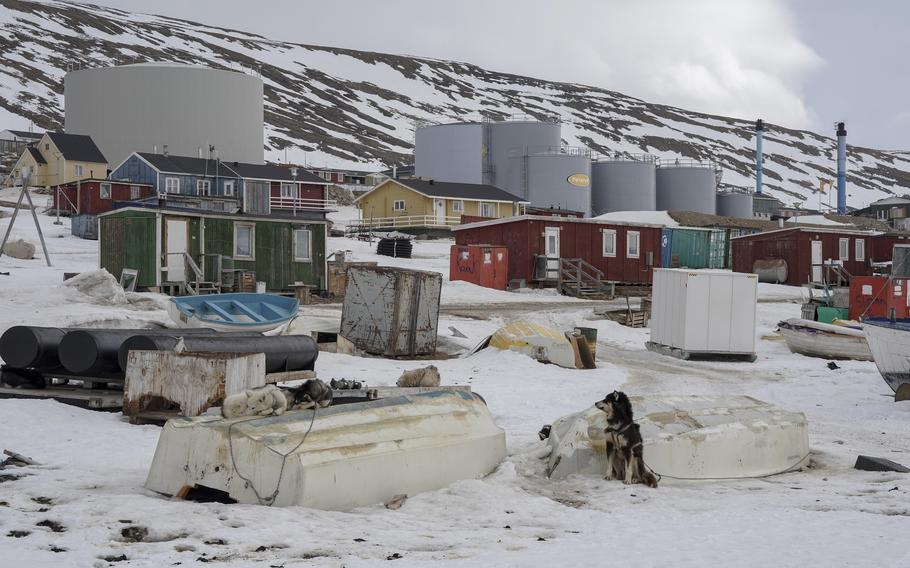
A team of researchers from Dartmouth is helping the community find alternate and renewable sources of energy and cut energy costs. One project is looking at house construction to better insulate the homes. (Bonnie Jo Mount/The Washington Post)
So PhD student Alyssa Pantaleo teamed up with Oshima’s husband, carpenter Kim Petersen, to come up with better-insulated alternatives. They created a modular design that could be easily built from materials that would fit inside a single shipping container. Petersen hopes to start using the design to build affordable homes for Qaanaaq’s fishermen in the coming year.
Next, the Qulleq researchers analyzed how Qaanaaq could meet its summertime electricity needs with solar power - allowing it to shut down its diesel generators for half the year. They found the switch could save Nukissiorfiit between $10,000 and $200,000 annually, and the electric utility is now in talks with Pantaleo about implementing the team’s recommendations.
Unlike most scientific projects, which are tightly focused on addressing a specific question or solving a single problem, the Qulleq team is taking an “all of the above” approach, including existing technologies and others they dream up, Albert said.
One researcher is working to adapt solar air heaters to work with Pantaleo’s model house. The devices have few moving parts, Albert said, and although they only work when the sun is shining, the heat they generate “comes completely free.”
Another former masters student is developing a simple turbine that can convert wind energy directly into heat for people’s homes. A variation on that design, installed at two houses last year, endured the Arctic winter while pumping out about 400 watts of energy - enough to heat a small room.
“It’s small, but it’s a proof of concept,” Albert said. She is now helping Petersen to apply for funding from the Greenlandic government to build a larger wind turbine to power the modular homes he plans to build.
Several of the project’s innovations have come from Oshima herself. Though she has no formal training as an engineer, a lifetime of making the most from Qaanaaq’s limited resources has instilled in her a knack for invention.
“When you are at the end of the world, you to have to fix many things without help,” Oshima said.
One of many examples: a fish dehydrator she built using materials scavenged from the dump. If other fishermen had this, she told Albert, they could filet and process their catches in town - allowing them to charge more for their hauls.
So the pair designed a new, mobile version of the device that runs on solar power. Qaanaaq’s fishermen will take the first prototype out onto the ice this spring.
Sitting in the entrance to her own tiny, fishing hut, surrounded by the vast white silence of the sea ice, Oshima said she hopes the project will help people survive in this frozen and isolated corner of the planet for generations to come.
“It’s not just for me,” she said. “It’s for the Arctic. It’s for all the cold and dark areas.”